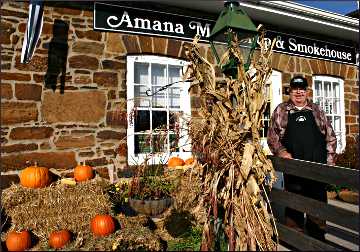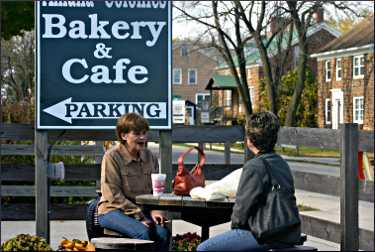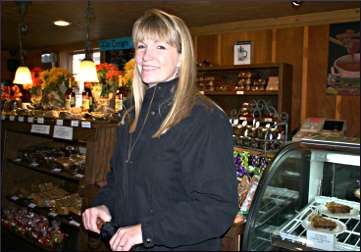Eating in the Amana Colonies
In eastern Iowa, a historic village has a long tradition of feeding people well.

© Beth Gauper
Before 1932, the pious, hard-working people of the Amana Colonies were the only people in Iowa who got to eat out every night.
Members of the pacifist Community of True Inspiration, they emigrated from Germany and built seven villages on 25,000 acres of eastern Iowa farmland. For nearly 90 years, they lived communally, pooling resources and skills.
Butchers, brewers and winemakers turned out goods for everyone, and meals were served in 50 communal kitchens.
Then, when the Great Depression crippled trade, the villages dropped the communal system. Suddenly, there were 50 kitchen bosses who needed a job.
That's when the restaurants opened, though the hospitality tradition already was well established.
"People would get off the train to shop and pay 15 cents for a meal in one of the kitchens," says Paula Blessman of the Amana Colonies visitors center. "The cooks were used to serving family-style, where the side dishes just keep coming."
Tourists still come to the Amanas to eat hearty food and to shop for treats: Old World sausages, handmade chocolates, imported German delicacies, fruit wines and craft beer.
Amana is the largest and most commercial village. When I was there on a food tour one October, Blessman started by answering the question everyone asks.
"For one thing, we're not Amish," she said. "We get that every day at the visitors center from people looking for caps and buggies."
The name the people gave their Iowa colonies, Amana, comes from the Bible and means "remain true." They welcomed technological innovations — 'When tractors were developed, we were all over that,' " Blessman said — and were comfortable with outsiders.
But they continued to speak their native German, went to church 11 times a week and were happy to live simply.
"It wasn't a flashy kind of group," she said. "It was frowned upon to make something for beauty's sake, but if it served a purpose, they'd make it really pretty. We have a lot of beautiful matchboxes."
Shop signs are uniform, plain black with white block lettering. Villages look much as they did a century ago: Narrow sidewalks line streets, so residents could walk to kitchens and general stores, where each family was given credit according to its size.

© Beth Gauper
Split-timber fences line tidy lawns, to keep off beef cattle that were herded through town. The rows of brick and stone cottages are wrapped with trellises, on which grapevines grow and also help insulate basements.
At Collectively Iowa, we sampled Royce Bennett's dry and off-dry red wines made with Iowa grapes, as well as more traditional fruit wines from other Iowa vintners.
"We're the oddball of the group," Bennett said. "We have five sweet wineries, and I felt like doing something different."
Amana Meat Shop and Smokehouse was around the corner, and jovial octogenarian Carl Oehl was waiting with slices of beef sticks, jerky, sausage and Schwartenmagen, or head cheese. But the tastiest morsel was ham dipped in Oehl's own homemade horseradish jelly.
Oehl is a descendant of the original settlers and lived around the corner in the house in which he was born.
"I'm the figure here, the big fat figure," he joked. "I've worked here since I was 10 years old, hanging meat over in the smokehouse." We sampled quite a bit, but he insisted on sending us off with waxed-paper doggie bags.
With seven more stops to go, Blessman kept us moving. On the way to Ackerman Winery, we walked past the Amana General Store, a gift shop that once sold staples.
"The kitchen bosses came here weekly for cocoa, sugar, salt, spices and other things made in the outside world," she said. " When they made things here in the village — soap, wine or beer — they'd say to the people, 'It's ready, you can pick up your share on Wednesday.' "
At busy Ackerman, Barb Kellenberger poured us samples of dessert wines — rhubarb, gooseberry, strawberry, peach, apricot and crimson cranberry, the perennial best seller.
I liked the red raspberry wine, which tasted like summer and made me wonder how I could pair it with chocolate.
"It's like putting a bunch of fresh berries in your mouth," Kellenberger said. "If you like to play with your wines, it makes a great raspberry vinaigrette. Or you can take half a cup, a handful of berries, some ice and ice cream or yogurt and make a smoothie."
Then we sat down for the main course at Ronneburg Restaurant, a former communal kitchen named for a castle in Hesse, the German state from which most of the original settlers came.
Chef Parrish Koele sent out dishes of broccoli salad, spinach dip, bread, potato dumplings, sauerbraten and wiener schnitzel.
He also put out a bowl of the fragrant spices used in the veal breading and a dish of gingersnaps, explaining how he uses them to give zing to the sauerbraten as it marinates over three days.

© Beth Gauper
Ronneburg has helped restore the authenticity of many traditional German specialties, which had become Americanized. Other restaurants, such as the Ox Yoke next door, also serve traditional dishes as well as such Iowa farm food as fried chicken, ham and pork chops.
Koele, like his cousin Carl Oehl, is a descendant, and he said his grandmother still wears a bonnet, prayer shawl and apron to church, where women and men still sit separately.
"They have a lot of traditions that are kept alive through the church," he said.
We had dessert at the Ox Yoke Inn, which is known for a bakery that turns out thousands of pies. Even so, the restaurant sometimes runs out of a particular kind.
"Many people who come here order dessert first, before they order their entrée," said Bill Leichsenring Jr., whose father left the colony in the 1920s to work in Milwaukee, where he patronized Mader's and decided to return and start a restaurant of his own.
We had the chocolate mousse dessert that won the 50th-birthday recipe contest and a slice of the even more famous rhubarb pie. Since beginning, the restaurant has expanded several times; we ate in the Woodshed Dining Room, named for its previous function.
"My father was a great promoter," Leichsenring said. "My sister and I always had to wait on vacations while he finished promoting the Amana Colonies."
From the Ox Yoke, we moved on to the Amana Colonies Bakery & Cafe for slices of white bread spread with apple butter and cherry-rhubarb jam.
At the Chocolate Haus, we watched an employee dip cherries and received an "antler," a large cluster of cashews topped with the shop's homemade caramel and a dollop of chocolate.
From the candy store, we walked to Millstream Brewing, on the 6½-mile mill canal that colony men dug in the 1860s. On warm days, the brewery's deck fills with beer samplers, but we stayed inside, drinking Iowa pale ale, Oktoberfest and the popular Schild Brau Amber out of little glass mugs.
Our last stop was the Village Winery, where vinter Don Krauss greeted us with hands stained blue from mixing 500 gallons of blueberry wine and 500 gallons of cranberry wine.
"I used 3,000 pounds of sugar, so I'm pretty sore," he said.
Since 1973, Krauss has produced such traditional wines as piestengel, Amana slang for rhubarb wine. To make that, he said, he needs 11 pounds of rhubarb to make one gallon of juice. In spring, he makes dandelion wine, placing newspaper ads to obtain adequate supplies of the yellow flower.
By the end of the tour, we knew a lot about Amana traditions as well as food.
"Amazingly, I spent my whole life in Iowa and I'd never been to Amana," said Nancy Aldrich of Cedar Falls. "But I'd been hearing about it for years. The food is the only thing I knew about this place for sure."

© Beth Gauper
Trip Tips: Eating and drinking in Amana
Getting there: Amana is half an hour west of Cedar Rapids and Iowa City, just north of Interstate 80. The other villages are two or three miles apart.
When to go: The busiest seasons are from May to October and from Thanksgiving to Christmas. There are four big festivals: Winterfest in January, Maifest in May, Oktoberfest in October and Prelude to Christmas in December.
Accommodations: In Amana, the Guest House Motel has 38 rooms in two buildings, one modern and one an 1860 sandstone building once used as a communal kitchen. 319-622-3599, 877-331-0828.
There are also many B&B inns.
Shopping: For more, see Truly Amana.
History: Check for walking tours and other programs at the Visitor Center. The Amana Heritage Museum is open daily from April through October and Saturdays in March, November and December, 319-622-3567.
Information: Amana tourism, 800-579-2294, 319-622-7622.
What about the Amish? There's a large community in southeast Minnesota, and several companies offer guided tours of Amish farms.
For more, see Amish country.